SPECIAL - Best of Belgium
Architectural Conservation Trust Launched
Iconic Encounters: Barcelona
SPECIAL - Casas Icónicas en España!
Inside UNESCO Icons: Houses That Made History - Part 1
Inside UNESCO Icons: Houses That Made History - Part 2
Czech It Out: A Stylish Soirée of Exhibition and Film
Sopot Hosts Icons of Czech Avantgarde Exhibition
Pioneers of the Dutch Modern House - Film Screenings
SPECIAL – Austria
SPECIAL – Czech Classics
SPECIAL - Vacances en France!
SPECIAL – Iconic Dreams Europe
SPECIAL – Iconic Dreams North America
Tautes Heim. Story & Details
Casa Gomis acquired by Spain's Ministry of Culture
Our Badge of Honour
New Year's Reception and Eileen Gray Screening
Funding Win Marks Anniversary of Mackintosh Acquisition
Modernist Houses Lost in the LA Wildfires
Casa d’Abreu Neto: Siza’s First Work
Pioneers of the Dutch Modern House
Iconic Encounters: London
Interview in Leading Catalan newspaper ARA
Record Number of New Iconic Houses - Part 1
Record Number of New Iconic Houses - Part 2
At Plečnik House: To Decide Where the Shadow Falls
A Story of Burnt Books and Broken Bricks
Remembering Irving J. Gill
Iconic Houses in the Media in 2024
Bauhaus Villa in Berlin For Sale
Historical Exhibition, Marie-Laure de Noailles, Painter, Conversation
Mackintosh’s Hill House Becomes an International Iconic House!
Istanbul’s Modernist Ataköy Housing Estate is At Risk
Early Furniture Designs by Le Corbusier on Permanent Display in Maison Blanche
Photo Report City Icons Amsterdam
Healing Through Architecture
Reopening An Iconic Modernist Landmark
City Icons Kick Off with Talk by Linda Vlassenrood
MORE MIES - Pure Architecture in Haus Lange Haus Esters
Through a Bauhaus Lens: Edith Tudor-Hart and Isokon
Modernism Week Lecture: 12 Years of Iconic Houses
Aluminaire House Grand Opening
Exhibition Icons of the Czech Avant-Garde
An Elementalist and Mediterranean Architecture
Icon for Sale - Loos Villa: Haus Horner
SPECIAL – UK Originals
SPECIAL – Dutch Delights!
SPECIAL – German Greats!
SPECIAL – Northern (High)Lights!
SPECIAL – Iconic Collective Housing
SPECIAL – Women & Iconic Houses
SPECIAL – Iconic Artist Residencies
Support the Frankfurt Declaration (on Housing)
Winy Wants a World Wonder
Welcome Atelier Volten!
Sleep in a Modernist Gem – Huis Billiet in Bruges
Iconic Houses in The Netherlands - 100 Years Van Zessen House
Exclusive Tour and Film Screening Package
The Last House Designed by Adolf Loos Will Be Built in Prague
Icons of the Czech Avantgarde
Icon for Sale - Casa Legorreta
Rietveld Day: 200 Enthusiasts Explored 3 Utrecht Icons
Hurray! 10 Years Iconic Houses
7th International Iconic Houses Conference A Huge Success
Meet Conference Co-Chair Iveta Černá
Meet Conference Co-Chair Maria Szadkowska
Eighteen Iconic Houses Under One Roof
17 June - 'Pioneers-film' Screening Amersfoort
Iconic Houses in The Netherlands - Van Eesteren House Museum
Welcome Margarete Schütte-Lihotzky Zentrum in Vienna!
Welcome Vila Volman! Jewel of Czech Functionalism
Movie Night: Adolf Loos- Revolutionary Among Architects
'Inside Iconic Houses' Case Study House #26 Webcast in Webshop
Inside Iconic Houses at Taut’s Home in Berlin
Rediscovering Forgotten Loos Interiors in Pilsen
'Inside Iconic Houses' - Online Tour Program
Iconic Houses in The Netherlands - The Diagoon House
Iconic Houses in The Netherlands - Rietveld Schröder House
Rietveld Houses Owners Association
Corberó Space: New Life for Hidden Jewel
Iconic Houses in The Netherlands - Pierre Cuypers' House and Workshops
Reeuwijk Celebrates Completion of Restoration Rietveld Homes!
Iconic Houses in The Netherlands - Van Doesburg Rinsema House
Welcome Rietveld's Van Daalen House!
Architect Harry Gessner Passed Away at 97
Watch Pioneers of the Dutch Modern House Now On Demand
Icon Saved: Dorchester Drive House
Welcome Umbrella House!
Iconic Houses in the Netherlands – Berlage’s Masterpiece
Iconic Houses in The Netherlands - Het Schip
Inside Iconic Houses - Tour of Maison Cazenave
Inside Iconic Houses Tours Vizcaya Museum & Gardens in Miami
Casa Masó Celebrates 10 Year Anniversary
Inside Iconic Houses tours Roland Reisley's Usonian Frank Lloyd Wright House
Rietveld’s Experimental Housing in Reeuwijk Saved
Serralves Villa after restoration
Portraits of the Architect - Interview with Gennaro Postiglione
Test Labs for New Ideas - Interview with Natascha Drabbe
Inside Iconic Houses - Isokon Building
Inside Iconic Houses - 16 December: Sunnylands with Janice Lyle
BCN-BXL Coderch-De Koninck - Beyond Time
New Chairman Architect Nanne de Ru on The Perfect Platform
Health and Home - Interview with Beatriz Colomina
A Life Less Ordinary – Interview with Valentijn Carbo
Invisible Women - Interview with Alice T. Friedman
Winy Maas on the Green Dip
Anita Blom on Experimental Housing of the 1970s
Women’s Worlds - Interview with Natalie Dubois
The Culture of Living - Interview with Robert von der Nahmer
Hetty Berens: A Fresh Take on Modernism
Niek Smit on Supporting Modern Heritage
Alice Roegholt on Amsterdam’s Working-Class Palaces
July is Iconic Houses Month
Hans van Heeswijk on The Pioneers of the Dutch Modern House
Wessel de Jonge on Dutch Icons at Risk
Save Maison Zilveli - Sign the Petition!
How a Building Tells a Story - Recorded Event
Toolkit for Owners of a Modern House
13 Aalto Sites Nominated for UNESCO World Heritage
Villa Beer At Risk - Sign the Petition!
Business Cards of Stone, Timber and Concrete in the Brussels Region 1830-1970
Exhibiting & Visiting Modernist Monuments
Fostering Well-Researched Responsible Design
ICONS AT RISK
Enjoy a virtual visit to the California House and a Q&A with architect Peter Gluck
Exhibition 'Modernism and Refuge'
A Hidden Gem of Postmodernism
New Centre for Historic Houses of India
An Online Chronicle of the Douglas House
Villa Henny, geometric style icon in The Netherlands
A Mendini temple in Amsterdam
IH-lectures USA & Canada Feb 2020 on Melnikov House
Sponsors and Friends
An Afternoon with the Glucks
Chandler McCoy on Making Modern Houses Sustainable
Catherine Croft: Getting Away from the Demolition Mentality in the UK
Patrick Weber on Discovering an Unknown Icon
Fiona Fisher on Iconic Interiors
Jocelyn Bouraly on Villa Cavrois
Mireia Massagué on finding success through a new kind of partnership
Danish Moderns – Looking Back at Our Mini-Seminar
Venturo house complements Exhibition Centre WeeGee’s offering
Lecture report: Remembering Richard Neutra
Hôtel Mezzara and the Guimard Museum project
We welcome 13 new members!
BREAKING NEWS: 8 Wright Sites Inscribed on Unesco World Heritage List!
LECTURE 29 August - Raymond Neutra: My Father and Frank Lloyd Wright
Iconic Reads
Iconic Houses End Year Message
City-ordered rebuild of landmark house stirs debate: Appropriate or overreach?
Kohlberg House Restoration in Progress
Planned Demolition of Rietveld Homes in Reeuwijk
Renovation Gili House in Crisis
An Iconic Saga
Restoring Eileen Gray’s Villa E-1027 and Clarifying the Controversies
Modernism on the East Coast
Iconic Houses in Latin America
Conference testimonials
House Tours May 2018
Expert Meetings
Natascha Drabbe - Iconic Houses: The Next Chapter
Terence Riley -KEYNOTE SPEAKER- on Philip Johnson
New era for Villa E-1027 and Cap Moderne
Hilary Lewis on Philip Johnson and his Glass House
John Arbuckle on Great House Tours
William D. Earls on the Harvard Five in New Canaan
Stover Jenkins on Working for Philip Johnson
Frederick Noyes on his Father’s House
Scott Fellows and Craig Bassam on their Passion for Preservation
Jorge Liernur -KEYNOTE SPEAKER- on Latin American Modernism(s)
Fabio Grementieri on Modernism in Argentina
Catalina Corcuera Cabezut on Casa Luis Barragán
Renato Anelli on Lina Bo Bardi’s Casa de Vidro
Tim McClimon on Corporate Preservation
Amanda Nelson on Building Donor Relationships
John Bacon on Planned Giving
Jean-Paul Warmoes on the Art of Fundraising in America
Chandler McCoy on Why Less is More
Katherine Malone-France on Moving with the Times
Anne Mette Rahbæk on Philanthropic Investments and Preservation
Peter McMahon on Saving Modern Houses on Cape Cod
Toshiko Kinoshita on Japanese Modern Heritage Houses
Roland Reisley on Life in a Frank Lloyd Wright House
5th Iconic Houses Conference May 2018
Kristin Stone, Pasadena Tour Company
Restoring the past: The Diego Rivera and Frida Kahlo Home Studio
Behind the Scenes: Hendrick de Keyser Association
Crosby Doe, Architecture for Sale
Latin America Special – Focus on Mexico
De Stijl in Drachten
Preserving the Nancarrow House-Studio
Meet the Friends - Nanne de Ru
Latin America Special – Focus on Brazil
Jan de Jong’s House is Latest Hendrick de Keyser Acquisition
Stay in a Belgian Modernist Masterpiece
In Berlin’s Modernist Network
Rietveld-Schröder House Celebrates De Stijl Anniversary
Meet Our New Foundation Board Members
Maintaining Aalto's Studio – Linoleum Conservation
Virtual Tour of a Papaverhof Home in 3D
Getty Grant for Villa E-1027
Plečnik House in Ljubljana
Iconic Dacha
Iconic Houses: A Bohemian Road Trip
Work in Progress: Capricho de Gaudí
11 Le Corbusier Homes now on Unesco World Heritage List
At home with Le Corbusier
Henry van de Velde’s Study in Haus Hohe Pappeln Restored
Lynda Waggoner reports
A Conference to Remember
4th International Iconic Houses Conference
Guest of Honor - Harry Gesner
Fallingwater: European Lecture Tour
Wright Plus 2016 Walk
Susan Macdonald, Getty Conservation Institute
John Mcllwee, Garcia House
Meet the Friends – Elisabeth Tostrup
Iconic Houses: The Story So Far
Willie van Burgsteden, designer Iconic Houses
Buff Kavelman, Philanthropic Advisor
Meet the Friends - Frederick Noyes
Sheridan Burke, GML Heritage
Meet the Friends - Raymond Neutra
Sidney Williams, Frey House
Franklin Vagnone and Deborah Ryan, Museum Anarchists
Meet the Friends - James Haefner
Toshiko Mori, architect
Malachi Connolly, Cape Cod Modern House Trust
Meet the Friends - Penny Sparke
Lucia Dewey Atwood, Eames House
Cory Buckner, Mutual Housing Site Office
Jeffrey Herr, Hollyhock House
Speaking Volumes: Building the Iconic Houses Library
Sarah Lorenzen, Neutra VDL Studio and Residences
Ted Bosley, Gamble House
Keeping It Modern - Getty Conservation Grants
Meet the Friends - Thomas Schönauer
Wim de Wit, Stanford University
Linda Dishman, Los Angeles Conservancy
Jesse Lattig, Pasadena Heritage
Join us in Los Angeles! Update
Work in Progress: Casa Vicens
Work in Progress: Van Wassenhove House
Work in Progress: Villa Cavrois
Work in Progress: The Pearlroth House
Conference calls!
Follow us!
Third Iconic Houses Conference a huge success
Conference House Tours Barcelona
Marta Lacambra, Fundació Catalunya-La Pedrera
Natascha Drabbe, Iconic Houses Foundation
Special speaker Oscar Tusquets
Jordi Tresserras, UNESCO Network ‘Culture, tourism and development’
Christen Obel, Utzon Foundation
Elena Ruiz Sastre, Casa Broner
Fernando Alvarez Prozorovich, La Ricarda
Tim Benton, Professor of Art History (Emeritus)
Susana Landrove, Docomomo Spain
Rossend Casanova, Casa Bloc
Icon at Risk: Casa Gomis / La Ricarda
Conference Program 25 November 2014
Jordi Falgàs, Casa Rafael Masó
Documentary La Ricarda
Marga Viza, Casa Míla/La Pedrera
Celeste Adams, Frank Lloyd Wright Trust
Conference 25 November 2014 at La Pedrera
Henry Urbach, The Glass House
Victoria & Albert Museum London November 12, 2013
Tommi Lindh, new director of the Alvar Aalto Foundation and Museum
Iveta Černá, Villa Tugendhat
Lynda Waggoner, Fallingwater
Kimberli Meyer, MAK Center
Rent a house designed by Gerrit Rietveld
Barragán House on Screen
Gesamtkunstwerk – An Icon on the Move
Triennale der Moderne 27 September - 13 October 2013
Prestigious Art Nouveau mansions in Brussels open
September 14 + 15: Heritage Days in Paris
June's New Arrivals: Museum Apartments
Iconic Houses is now on Twitter and Facebook
Corbu’s Cabanon: Reconstruction and Lecture
Projekt Mies In Krefeld: Life-sized model of the Krefeld Clubhouse
New arrivals: Spain special
MAMO: Le Corbu’s ‘Park in the Sky’ open 12 June
Taut's Home wins Europa Nostra Award
Annual Wright Architectural Housewalk: 18 May
Frank Lloyd Wright Homes on Screen
Message from the Editor
Neutra’s House on Screen
Michel Richard, Fondation Le Corbusier
Symposium The Public and the Modern House
Melnikov House on Screen
Iconic Houses in the media
Message from the Editor
Round Table Review
Eileen Gray House on Screen
Copy Culture
At Home in the 20th Century
New 20th century Iconic Houses website launches
Philippe Bélaval, Centre des monuments nationaux
SPECIAL – Iconic Collective Housing
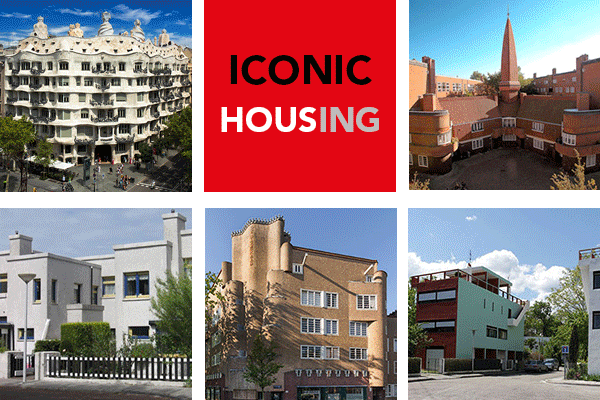
Iconic Houses isn’t just about detached 20th-century villas and the ideal homes of individual clients. It’s also about the experiments of avant-garde architects in designing idealistic collective housing for the masses. An increasing number of museums in developments like these operate as a historical ‘show home’ – a time capsule, displaying how factory or middle-class workers lived in the 20th century. These experiments in living were often progressive designs showing (mainly) improvements in sanitary and hygienic facilities. Later on, other ideals were added, as the examples below indicate. Each and every one of them is an idealistic design, intended to bring more joy as well as practical improvements to the lives of their residents.
Twenty of these collective housing projects are currently affiliated with our Iconic Houses network with a total of almost 200 modern house museum, and all of them can of course be booked for a guided tour and some for an overnight stay. So far, they are mainly in the Netherlands, Germany, France, Spain and Switzerland. Click for more information and to see where they are on our world map. They are listed here below in chronological order.
We want your tips!
We’re always looking out for new and inspiring examples. So, if you know a unique and unmissable house from the 20th century, please tell us about it by mailing info@iconichouses.org. Thanks for your suggestions!
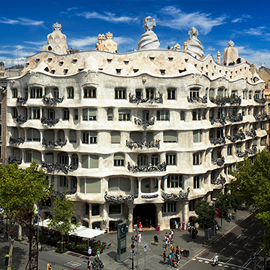 Casa Milà Apartment, Barcelona, 1912 Gaudí was commissioned to design an apartment house, with the aim of turning the main floor into a family residence for his client and leasing out the rest of the dwellings. Casa Milá is aka 'La Pedrera' (the stone quarry) in allusion to the resemblance of its façade to an open quarry. In 1984 UNESCO inscribed La Pedrera in its World Heritage List, for its exceptional universal value.
Casa Milà Apartment, Barcelona, 1912 Gaudí was commissioned to design an apartment house, with the aim of turning the main floor into a family residence for his client and leasing out the rest of the dwellings. Casa Milá is aka 'La Pedrera' (the stone quarry) in allusion to the resemblance of its façade to an open quarry. In 1984 UNESCO inscribed La Pedrera in its World Heritage List, for its exceptional universal value.
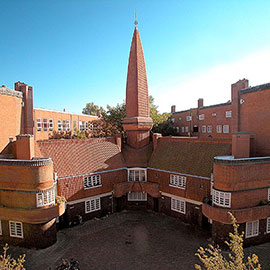 Het Schip Model Home, Amsterdam, 1921 ‘Workers’ palace’ The Ship, by the Dutch architect Michel de Klerk, is renowned worldwide. The building contained 102 dwellings for the working classes, a small meeting hall, a post office and a school. It is built in the style of the Amsterdam School, a Dutch version of Art Deco. Besides looking like a ship, its appearance is unconventional from all angles.
Het Schip Model Home, Amsterdam, 1921 ‘Workers’ palace’ The Ship, by the Dutch architect Michel de Klerk, is renowned worldwide. The building contained 102 dwellings for the working classes, a small meeting hall, a post office and a school. It is built in the style of the Amsterdam School, a Dutch version of Art Deco. Besides looking like a ship, its appearance is unconventional from all angles.
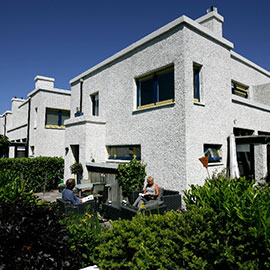 Papaverhof, The Hague, 1921
Papaverhof, The Hague, 1921
Papaverhof is a court with 128 middle-class homes laid out in a horseshoe-shaped ring around a sunken park that are part of residential complex Daal en Berg, which was built to a design by De Stijl architect Jan Wils. This listed complex is counted among the Top 100 of the Dutch monuments and is the only residential complex in the world, designed to the views of De Stijl.
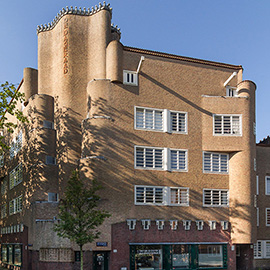 De Dageraad, Amsterdam, 1923
De Dageraad, Amsterdam, 1923
Cooperative Housing Association De Dageraad (The Dawn), realised a social housing estate, designed by young high-profile architects Piet Kramer and Michel de Klerk. Since 2011, Museum Het Schip has a satellite visitors centre in a former shop in De Dageraad. The centre forms a home base for tours of the Amsterdam School in Amsterdam South.
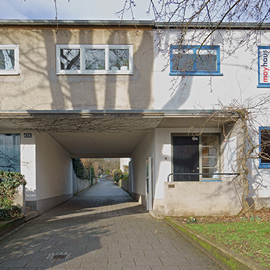 mayhaus, Frankfurt, 1928
mayhaus, Frankfurt, 1928
The mayhaus is the model house of the New Frankfurt. It has been restored and returned to the condition it was around 1928. It thus exemplifies the political, economic and artistic reforms for which Frankfurt's mayor Ludwig Landmann received worldwide attention at the end of the 1920s when he commissioned municipal councillor and architect Ernst May to solve the housing shortage.
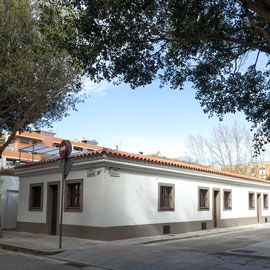 Casas Barates Bon Pastor, Barcelona, 1929
Casas Barates Bon Pastor, Barcelona, 1929
The restoration of the houses in Barcelona’s Carrer de Barnola illustrate and trace the history of the domestic interiors of the city’s working classes with all their diversity in the Bon Pastor neighbourhood and its housing between 1929, designed and built by the Municipal Housing Board, and 2016, when the single-family houses gave way to new blocks of social housing.
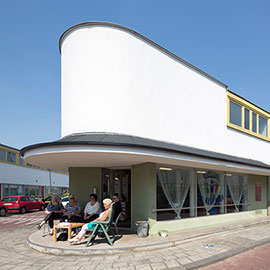 De Kiefhoek, Rotterdam, 1930
De Kiefhoek, Rotterdam, 1930
The Kiefhoek is a housing estate to house workers of originally 294 family houses and several central facilities, designed by architect J.J.P. Oud according to the principles of the Modern Movement. Oud used an ingenious ground plan to create maximum living space in each dwelling, that can be experienced during your visit.
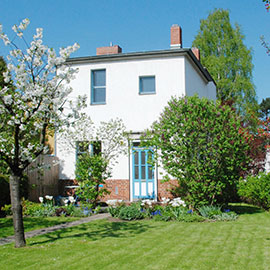 Taut’s Home, Berlin, 1930
Taut’s Home, Berlin, 1930
Travel back in time to Berlin's stylish 1930s accommodation at the UNESCO-World heritage site at the Horseshoe Estate. Suitable for up to four guests, Taut’s Home is a cultural treasure with the character of a museum and a real-life experience of design history. This is probably the closest you can get to the spirit of emergent Modernism and the Golden Twenties in Berlin.
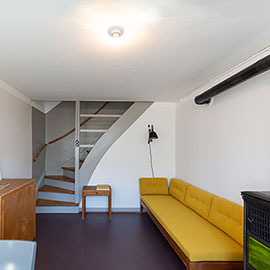 Ein Haus WOBA, Basel, 1930
Ein Haus WOBA, Basel, 1930
Within the framework of the first Swiss Housing Exhibition Basel (Schweizerische Wohnungsausstellung Basel – in short WOBA), similar to the Housing Estates in Stuttgart's Weissenhof Siedlung, or the Modernist housing settlements in Brno or Vienna, the first modernist housing settlement in Switzerland was realized in 1930. Thirteen architects in search of affordable and efficient working-class apartments turned WOBA into one of the most exciting housing experiments of early Modernism in Switzerland.
 Haus Rietveld in Werkbundsiedlung Vienna, 1931
Haus Rietveld in Werkbundsiedlung Vienna, 1931
Gerrit Rietveld, known for his iconic 1924 Schröder House in Utrecht, was one of the few foreign architects invited to contribute to the Vienna Werkbund Estate. The split-level Haus Rietveld has five levels and a basement. It was faithfully restored in 2015 by Tillner & Willinger Architekten, with its original colour concept. Rietveld differentiated the rooms spirally based on their functions and heights.
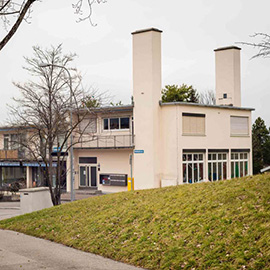 SWB Guest Apartment, Zurich, 1932
SWB Guest Apartment, Zurich, 1932
Stay at the SWB Guest Apartment in the cooperative settlement Neubühl. Designed by an architect collective around Paul Artaria, the apartment lets you experience living in a unique icon of early modernity. Living as if you were on holiday was the title of the prospectus for the first letting of these apartments in the early 1930s.
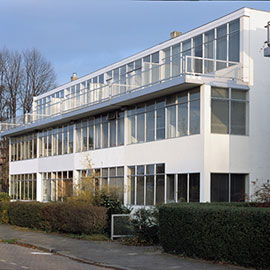 Erasmuslaan Model Home, Utrecht, 1934 The Rietveld Schröder House is not the only house that Gerrit Rietveld designed in Utrecht. Others include the nearby housing blocks on Erasmuslaan: a block of four townhouses (1931), followed by an apartment block (1934). In October 1931, Rietveld furnished one of the town houses to serve as a model home. The Centraal Museum has reconstructed this interior now to visit.
Erasmuslaan Model Home, Utrecht, 1934 The Rietveld Schröder House is not the only house that Gerrit Rietveld designed in Utrecht. Others include the nearby housing blocks on Erasmuslaan: a block of four townhouses (1931), followed by an apartment block (1934). In October 1931, Rietveld furnished one of the town houses to serve as a model home. The Centraal Museum has reconstructed this interior now to visit.
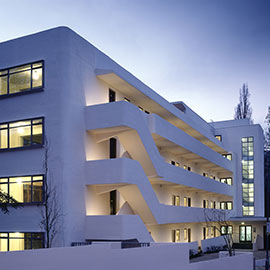 Isokon Flats, London, 1934
Isokon Flats, London, 1934
The Isokon Flats were a progressive experiment in a new way of living by architect Wells Coates, who was greatly influenced by Le Corbusier. The building soon attracted a great number of leftwing intellectuals and artists, and from 1935 no fewer than four Bauhaus teachers, among whom were Marcel Breuer and the very founder of the Bauhaus school; Walter Gropius.
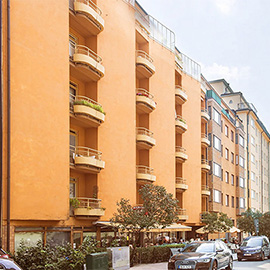 Markeliushuset Collective House, Stockholm, 1935
Markeliushuset Collective House, Stockholm, 1935
Architect Sven Markelius and sociologist and social democratic politician Alva Myrdal planned this 57-unit estate in the centre of Stockholm. The purpose was to emancipate women and give full-time working couples with children as well single professionals the opportunity to get help with various everyday tasks through the house's collective functions, under the motto “Individual culture through collective services”.
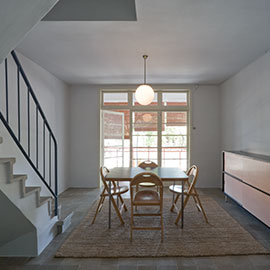 Casa Bloc, Barcelona, 1932-1939
Casa Bloc, Barcelona, 1932-1939
The apartment building was initiated by the Catalunya Government with the objective to create quality modern housing that met the basic standards of living for workers in need. Designed by architects Josep Lluís Sert, Josep Torres Clavé and Joan Baptista Subirana. Built using ideologies of the GATCPAC, one of these apartments has now been restored to its original state.
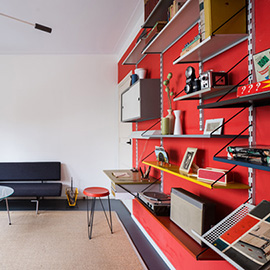 Van Eesteren House Museum, Amsterdam, 1952 The apartment in Slotermeer, a typical post war suburb planned by Cornelis van Eesteren, member of the ‘De Stijl’ movement. Inspired by modernists Le Corbusier and Gropius, he developed in 1932 a plan to prepare Amsterdam for growth up to a million habitants. It had much influence on the discussion on modernism and functionalism in European architecture.
Van Eesteren House Museum, Amsterdam, 1952 The apartment in Slotermeer, a typical post war suburb planned by Cornelis van Eesteren, member of the ‘De Stijl’ movement. Inspired by modernists Le Corbusier and Gropius, he developed in 1932 a plan to prepare Amsterdam for growth up to a million habitants. It had much influence on the discussion on modernism and functionalism in European architecture.
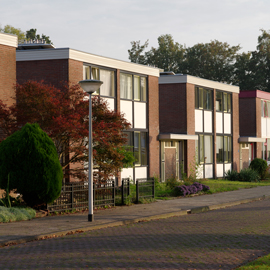 Polman House, Nagele, 1956 Nagele is the only 'flat-roof village' in the Netherlands and an icon of the Dutch Nieuwe Bouwen style - the Dutch version of Modernist or Bauhaus architecture and an early example of post-war social housing. In Polman House, ordinary people could live in a semi-transparent house, designed by Lotte Stam-Beese and Ernest Groosman. The kitchen and living room were separated from one another by a partition wall made of glass, allowing the sun to shine right through.
Polman House, Nagele, 1956 Nagele is the only 'flat-roof village' in the Netherlands and an icon of the Dutch Nieuwe Bouwen style - the Dutch version of Modernist or Bauhaus architecture and an early example of post-war social housing. In Polman House, ordinary people could live in a semi-transparent house, designed by Lotte Stam-Beese and Ernest Groosman. The kitchen and living room were separated from one another by a partition wall made of glass, allowing the sun to shine right through.
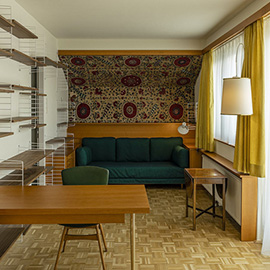 Margarethe Schütte-Lihotzky Zentrum, Vienna, 1969
Margarethe Schütte-Lihotzky Zentrum, Vienna, 1969
The former apartment of Margarethe Schütte-Lihotzky, Austria's most important and internationally renowned female architect, where she spent the last 30 years of her life, has been preserved. Schütte-Lihotzky is known for her design of the 'Frankfurter Küche' that she designed in 1926 for Ernst May's Neues Frankfurt project and which is considered the archetype of the modern fitted kitchen.
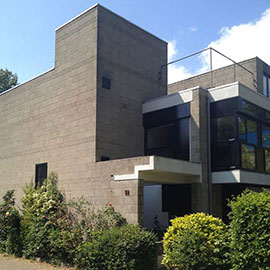 Diagoon House, Delft, 1971
Diagoon House, Delft, 1971
The Diagoon House, designed by Herman Hertzberger and built in a suburb of Delft, was originally intended to develop an entire residential area. Eight experimental homes were built as prototype. The house is conceived as a semi-finished product to give people more influence over the design of their own homes. It is to be completed and extended by the residents themselves.
 Cube House, Rotterdam, 1984
Cube House, Rotterdam, 1984
The Cube House, also called pole house or tree house, is a design by Dutch architect Piet Blom. A tilted cube on a pole resembles an abstract tree. There are 38 dwellings (of 100m2) and two big cubes on top of a pedestrian bridge. Each house has three levels: storage and entrance hall in the pole; living/kitchen, bath/bedrooms and loft in the cube.
Posted 29 January 2019, updated July 8, 2024